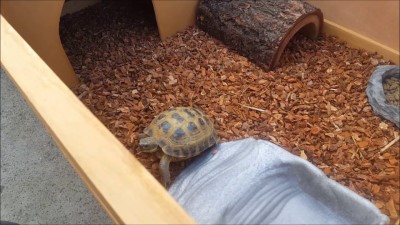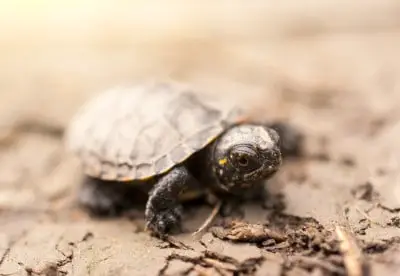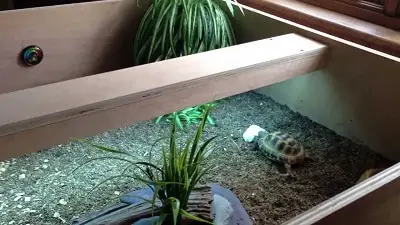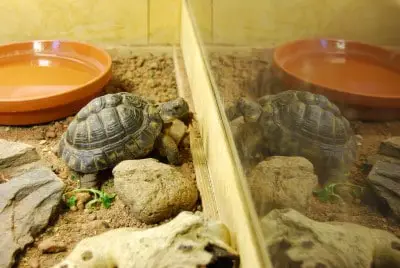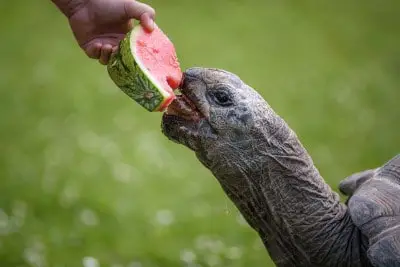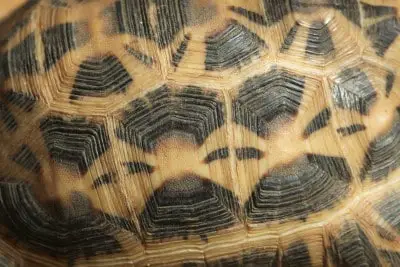Tortoises are one of the longest living reptiles, with most living for an average of 170 years. Most exotic animal owners admit that they love tortoises because they can make good lifelong companions. Indeed they can stay in the family for generations, depending on the species and environmental conditions.
Various tortoise species have different average lifespans as summarized in the table below;
| Tortoise Species | Average Lifespan in Years |
| Pancake Tortoise | 30 |
| Indian Star Tortoise | 35 |
| Russian Tortoise | 40 |
| Marginated Tortoise | 50 |
| African Spur-Thighed Tortoise | 70 |
| Hermann’s Tortoise | 75 |
| Greek Tortoise | 100 |
| Galapagos Tortoise | 120 |
As we take a closer look at various tortoise species’ lifespans, we will further discuss the general factors that determine how long they live and give you tips to help your tort live longer. Read on as we give you more details about the oldest vertebrates in the world.
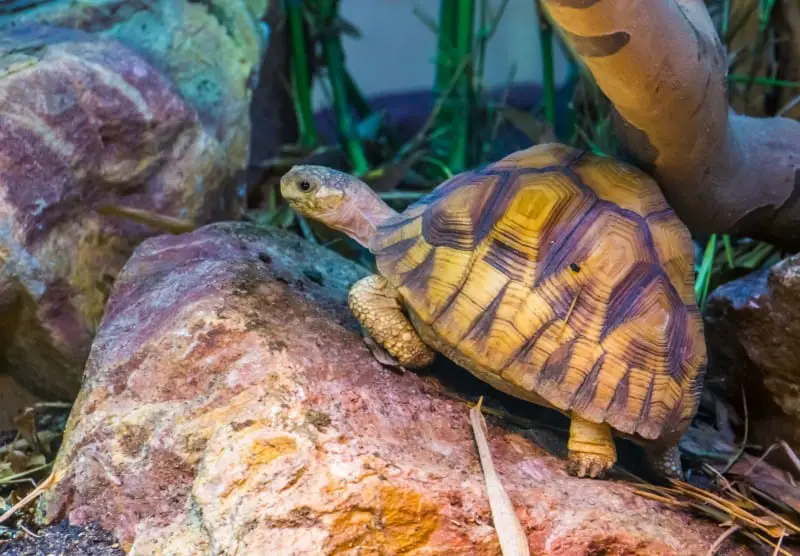
What Is the Tortoise’s Lifespan?
It may not be objective to state how long a tortoise can live because several factors come to play. Therefore, the best way to go is by estimation. Nevertheless, even our answers will rely on the proven findings, of which there may be older tortoises in the wild that we are yet to discover.
The longest living tortoises are the giant Galapagos and Aldabra tortoises that live for more than a hundred years. Records show that one of the oldest tortoises, Harriet, lived for 175 while another, Jonathan, is at around 189. The smaller species like the Pancake and the Indian star have shorter life spans of around 30-50. However, you can still find giant tortoises that lived for a short time and small ones that neared the century mark. Those in captivity are also known to live for longer than wild tortoises.
Undoubtedly, tortoises outlive other animals in the wild, with some living for generations, way past their initial owners. Generally, they can live for 70-150 years. By far, the most interesting tortoise is the Galapagos and Aldabra. Members of these species survive in the wild for longer than a century, with others going up to 200 years. Although their ages are only estimates, there is evidence that proves that one tortoise Adwaitya reached 225.
The Egyptian and Greek tortoises are also lucky enough to reach and, at times, surpass the century mark. Following on the ranking is Hermann’s species that average at 75 years. The Marginated, Leopard, Sulcata, and Red-footed species can also live past half a century. On the other hand, smaller ones like the Pancake, Indian Star, and the Russian tortoises average at 30 years.
Other tortoises live an average of 80 years and, in extreme cases, for a century. As stated, there are several factors to consider. It is not certain that your Galapagos will live past a century; it may fall ill or be attacked by a predator. Similarly, there are long-living small tortoises, as long as they get great care and are safe from predators.
Various Tortoise Species and Their Lifespan
No other reptile lives as long as the tortoise. Large tortoises also tend to live longer than small species. We went on to find out for how long various tortoise species can live.
The Sulcata Tortoise
The Sulcata/ African spurred is one of the most popular pet tortoises. They are generally hardy, live primarily on vegetation, and rarely hibernate. Most of them live for up to 70 years when in the wild, while pets live longer. If they get proper care, the Sulcata can reach a century, but this may be an extreme case.
Russian Tortoise
Most tortoises of this species are regular-sized, with most reaching 10 inches. Therefore, they are smaller than the Hermann’s. They are known to live for up to 40 years, making them one of the shortest living tortoise species.
Hermann’s Tortoise
This species is another popular one among pet owners. They reach 11 inches; hence, they are not as large as the giant pet species, but they still need to live outdoors. Their lifespan ranges between 50-60 years, but some in captivity can get older. The oldest recorded Hermann’s was at 110 years.
Red Foot Tortoise
These tortoises are famous for their red marks on their bodies. They are mostly medium-sized, reaching lengths of 12 inches and some 18 inches when fully mature. They are also not long-living like most tortoises since they can live for 30-50 years when in captivity.
Indian Star Tortoise
These species are infamous for being susceptible to ailments, thus are quite tasking to keep as pets. They can grow to medium sizes, but most are unable to reach full maturity. They can live for up to 40 years in the wild, but in captivity, the Indian Star can reach 80 years with proper care.
Egyptian Tortoise
This breed is also known as Kleinmann’s, Negev, or Leith’s tortoise. The species is endangered and is found in Egypt, Israel, and Libya. The reptile can reach full maturity in about seven years. With proper care and maintenance, Leith’s tortoise can have a life expectancy of about 70-100 years.
Marginated Tortoise
This reptile is native to Southern Greece, with a handful in Italy and the Balkans. The species is about 14 inches long and lives for 25-50 years, depending on the environment. The tort is an arid dweller; therefore, it is adapted to harsh environments.
Galapagos Tortoise
It is one of the largest tortoise species in the world, native to the Islands of Galapagos. These reptiles are giants and can live for over 100 years in the wild. However, those in captivity are well treated and get good medication, enabling them to live for over a hundred years. A good example is Jonathan, the tortoise, who is believed to be the world’s oldest animal alive at about 189 years today.
Leopard Tortoise
These tortoises live in the sub-Saharan part of Africa. Although they are not endangered, they are experiencing habitat loss, and with time they may be threatened. Although researchers approximate its lifetime to be anywhere within 50-100 years, their lifespan in the wild isn’t well understood. If you intend to keep one, the chances are high that it can outlive you.
Greek Tortoise
It is a species in the family of Testudinidae and one of the five species of Mediterranean tortoises. The tortoise is native to Southern Europe, North Africa, and Southwest Asia. Greek tortoises make good pets, and while in captivity and under good care, they can live for as long as 100-150 years. Some researchers even claim that under good conditions, the animal can surpass two decades.
Pancake Tortoise
African Pancake tortoises can live for over 30 years. The reptiles are major inhabitants of East Africa, and you are certain to find them in Tanzania or Kenya. You can also find them in Zimbabwe and Zambia. Their typical is semi-arid, tropical, and subtropical climates. The torts are small at about 7 inches long and can squeeze its body on rock crevices for shelter.
Read more: 14 Best Pet Tortoises For Beginners: Small To Large (With Pictures)
Why Do Tortoises Live Longer?
If you are a veteran keeper or a beginner, it is best to know how long your pet tortoise can live. It can help you decide the type of animal you have and its life expectancy. Understanding the reptile’s lifespan can help you place your strategies right because having these exotic friends at home can influence the order of our lives and behavior.
A tortoise can for over a hundred and fifty years due to its low metabolism and ability to hibernate for months. The slowed metabolism means less active systems, which will surely last longer. Also, tortoises have developed an improved defense against predators (hard shells); hence, reducing these reptiles’ predatory killings. Other factors like location, size, diet, and maturity time also have a role to play.
1. Metabolism
Tortoises digest food slowly, and you can notice the same speed in their movements. The system doesn’t synthesize a lot of energy for body activities that they don’t require. Unlike humans, these reptiles are cold-blooded; therefore, they don’t need to generate heat to warm their bodies. Instead, they use what is available in the environment.
Hyperactive animals die sooner because food digestion may release harmful substances into their system due to the chemical reactions involved. These unwanted toxins accumulate in the animal’s body over a long time, resulting in damaged cells and tissues, which in turn exhibit signs of old age and finally dispatch.
On the contrary, an animal with a very low metabolism wouldn’t damage the body tissues and cells, however old it may look. You can notice a similar case during hibernation. At this time, the animal’s metabolism is far below normal, and the tortoise doesn’t eat, letting the body slowly consume what is in the reserves. The seasonal inactivity period is a contributing factor to the tortoise’s long lifespan.
2. Defensive Mechanism
Researchers also argue that torts have a longer lifespan due to their hard shells. It protects them from predation, making it hard for them to fall prey.
Therefore, defence, coupled with the remarkably slow metabolism, could be the most eminent reason tortoises can live for centuries. A good example of a long-lived one is Adwaita, who has been alive for an estimated 255 years in Kolkata, India.
3. Size
Researchers believe that the size of a tort also plays a role in its life expectancy. Giant tortoises can live longer than smaller ones. Arguably, the surface area to volume ratio applies in this case. Smaller reptiles have a lower surface area to volume ratio; hence, their metabolism is higher. Thus, a large tortoise breed can live for very many years when in a favorable environment.
4. Late Reproduction
Tortoises are slow to eat, walk, and in performance of organ functions. This characteristic is also evident during reproduction. It orchestrates a slower growth making them reach sexual maturity much later. Most of these reptiles can reproduce at about 20 years which is unheard of among reptiles.
Researchers argue that other animals reach maturity earlier because they are vulnerable to predatory attacks. If they are in large numbers, some may survive while others fall prey. Tortoises are less prone to hunting by predators; therefore, they can live longer and get many offspring in their stretched life of about 100 years.
5. Diet
It is known that what you eat will affect your health, and if you need to live a better and longer life, you need to be careful with what you eat. Most tortoises are herbivorous, meaning that they feed on plant products that are easier to digest, unlike meat. Vegetables require less energy to breakdown, and since torts release a minimal amount of energy, veggies make the top of their list.
Meat is mostly associated with bad health and infection, but with a plant-based diet, your buddy is sure to live a healthy life. On the other hand, some torts feed on flesh, which means that their body metabolism increases for digestion to occur, and increased tortoise body metabolism indicates a decreased life expectancy.
6. Location
The tortoise’s habitat also matters a great deal. Pets and wild animals have different life spans. Tortoises that live in the field are exposed to lethal predators, unlike those in captivity that get good food and protection. Such tortoises are likely to live to their fullest. In the wild, tortoises have to deal with harsh desert environments, enemies, and scarcity.
Factors Affecting the Tortoise’s Lifespan
Close observation of a species is the surest way to tell its lifespan. For those living in the wild, scientists use factors like tooth wear a bone structure. It gets quite challenging to observe tortoises since most live in the wild, and we cannot track all of them down. However, let’s look at factors that influence the tortoise’s survival when in the wild.
The Environment
The temperature in their surroundings determines cold-blooded creatures’ body functions like metabolism rate. The lifespan also varies depending on favorable environmental conditions. In most cases, it is the environment that dictates whether the tortoise will thrive or not. These factors also contribute to the reptile’s chances of survival.
For instance, if animals in the area are susceptible to predatory attacks, their probability of survival reduces significantly. Also, if drastic changes in the climate are lethal to the tortoise, their population is likely to decrease. Lastly, interferences in growth and development cause the tortoise’s average lifespan to reduce.
Survival Patterns
Animals’ lifespan depends on their environment’s survival patterns. The individual animal’s ability to adapt also has a major role to play. The ones that don’t adapt well to the environment’s changes will die faster than those best adapted. If they migrate to areas with unfavorable conditions, unfit for animal survival, most will also die. That said, if the tortoise lives in the same conditions and adapts well to it, the chances of surviving past a century will significantly increase.
If other factors remain constant, the animals will survive until they die naturally, and given that the tortoise is a hardy creature, they may last way over 100 years. Survival is also dependent on the animal’s living conditions. Notably, those in captivity tend to outlive those in the wild. Pet tortoises get food, water, and protection, all necessary for life. In contrast, those in captivity face adversities such as scarcity and predatory attacks.
Natural Causes
In some cases, even the tortoises with the longest average lifespan may live a short life due to natural causes. The main cause of death among wild animals is malnutrition. When the food is scarce during certain times of the year, the tortoise’s life is endangered. They need nutrients necessary for their overall growth; or else, they get deficiency-related issues.
Secondly, the tortoise may get severe injuries from external attacks or mishandling. There are cases of children or misinformed people turning them upside down or accidentally dropping them, leading to internal and external issues. Other house pets may also be to blame for sudden deaths among tortoises. They may scratch, bite, or transfer some diseases to them.
Your tortoise may also get scared and stressed when another large animal is present. Illnesses also affect the tortoise’s survival. Diseases occur due to unsanitary conditions and improper diet. Even those safe in captivity can still get severely ill and die.
How To Help Increase Your Tortoise’s Lifespan
It is every tortoise owner’s dream for their tortoise to be a lifetime companion. It is perhaps the main reason why more and more people are purchasing tortoises as pets. Therefore, it is imperative to know how to ensure that your tortoise lives longer, happy, and healthy.
Read on for tips to help increase your tortoise’s lifespan.
Sanitation
Tortoises in captivity live longer because they have good owners to take care of them. One role of an owner is to clean up after them and keep their enclosure as clean as possible. It means disposing of their droppings and thoroughly cleaning their enclosure and everything in it.
Tortoises tend to leave behind bits of their food, which rot fast and harbor bacteria. Therefore, it would be best if you disposed of these substances as soon as possible to prevent contamination.
Secondly, it is easy for a tortoise to host a salmonella infection on its skin if the enclosure is unsanitary. These infections can easily transfer to you and lead to severe ailments. Your pet is likely to live longer in a clean and bacteria-free environment, unlike its counterparts in the wild.
Diet
With the best diet, the tortoise has better chances of survival. The food has to be nutritious and in the right quantity. They are primarily carnivorous; hence, they need many vegetables for their body and immunity to develop. The nutrients in vegetables help them with minerals and vitamins. For instance, calcium aids in bone and shell development, and without it, the tortoise is susceptible to illnesses such as Metabolic Bone Disease.
Fruits should also be in their diet but in moderation; otherwise, the tortoise may become obese. However, their dietary requirements vary depending on the tortoise’s species. First, your best bet is to understand your tortoise’s species to know what they need for optimal survival.
Stress
Although most people ignore this, stress has a direct impact on your pet’s lifespan. Tortoises, for instance, are known to develop severe medical conditions due to high-stress levels. It is also possible to scare a tortoise to death literally. They easily get frightened by predators, unfamiliar humans, other large tortoises, and pets.
Stress can lead to a lack of appetite, which means that your pet won’t eat properly, giving room for diet-related illnesses. Therefore, it is advisable to give a new pet some space to get used to its new surroundings. It would be best to keep it safe from any possible predators or other pets in the house.
Love and Care
When an animal gets all the love and care from the owner, its lifespan greatly increases. It means giving them all they need to grow and develop, including fresh air, sunshine, and exercise.
Sunshine is not only a source of heat when their temperature drops but also a vitamin D source. Besides getting them out to bask, you can also provide an alternative artificial source like a heat lamp. As a result, they get their much-needed vitamins and can relax. Breathing in fresh air is also vital for all animals. They need to walk around and play, which helps improve their health hence a longer lifespan.
Gaining More Insight
It is also important to understand your pet. Learn the species characteristics, their dietary requirements, lifespan, and any other useful information. This information will help you to treat your pet better and provide all that it needs for optimal survival. Also, learn about your pet’s personality; not all tortoises are alike.
Similarly, it is vital to know that a tortoise’s species is not a definite indication of how long it will live. A tortoise’s lifespan depends on the individual; some will surpass their average species’ lifespan, while others will live a shorter life due to certain unavoidable circumstances.
Final Take
There’s no definite answer to the question “How long does a tortoise live?” Several factors decide whether the reptile thrives or not. Some of the factors include its diet, size, species, and location.
Most tortoises can live up to 80 years if all other factors are constant. As long as the tortoise gets a proper diet and it doesn’t face predatory attacks, its lifespan will significantly increase. Similarly, large tortoises and those in captivity live longer than their counterparts in the wild.


